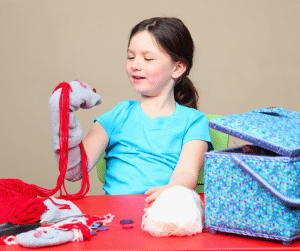What is working memory?
As a Speech Pathologist who has been working in the area of literacy and learning difficulties for many years, “working memory” is a term that comes up often. Not only does it come up often, but I feel that in my professional opinion, it has a HUGE impact on not only our ability to learn, but our entire lives. This stems from my personal experiences with working memory, and the experience of doing long-term therapy with children and adults who have working memory difficulties.
Working Memory predicts academic success from kindergarten to university – and is linked to learning in those with ADHD, dyslexia, and Autism. This essentially means that the smartest person in the classroom is not always getting the best marks. I don’t know about you – but this little nugget of information made me feel pretty good!
I was absolutely thrilled to sit down with Dr Tracy Packiam Alloway recently for our Spot Family podcast (LISTEN HERE), to have a chat about working memory, it’s impact, how we can train our working memory, and being a children’s author (but more on that later!) Tracy is an award-winning psychologist, professor, author, and TEDx speaker. She has published 13 books and over 100 scientific articles on the brain and memory (wow!)
She is an Associate Editor for the journal of Applied Cognitive Psychology and the journal of Educational & Developmental Psychologist and is on the Editorial Advisory Board for the Journal of Research in Reading. Her research is in the top 10 cited list by Scopus and cited over 1000 times! She blogs for Psychology Today and Huffington Post. (Quite the list of achievements, you can see why I was so excited to meet her!)
Now, Dr Alloway is the expert here, so I am keeping this blog in the same question & answer format as the podcast, so you don’t miss a thing!
Heidi: Firstly, I’d love for you to introduce yourself, tell us a bit about your journey as a psychologist, professor and Dr, and then we’ll get stuck into the juicy stuff!
Dr Alloway: Sure, well I got my PhD at the university of Edinburgh in the UK, and I worked there, and really got excited about working memory when I was doing my first government funded project in the UK, and it was a huge project working to understand at Kindergarten- what are the key factors we need to know about a child’s learning that could help us understand how successful they would be in the classroom and beyond, and once I got in there and I had to look at these different factors, I just began to be so excited about the role working memory was playing, and I guess you could say I never looked back, I just wanted to keep doing more, understanding working memory and learning it in different aspects.
Heidi: I’m going to jump straight in – there are so many things that I could ask you – but today I thought we might focus on children and working memory.
What is your definition of working memory? How do you describe it to parents?
Dr Alloway: I would think of working memory as your brain’s active memory. We know that the front of the brain, the prefrontal cortex (if you touch your forehead) , that’s the part of your brain that’s working extra hard when you’re using your working memory. I like to think of working memory like a post it note – it’s a temporary space that we have, that we pull up information that we know from our long term memory (facts, knowledge and so on), and we kind of jot it on our post it note (our working memory) and we use it for a conversation, for an interview, for an exam. So it’s not a storage place, as such, it’s really a holding zone where we bring in other sources of information, so we can use it, we can process it, and it’s really important in the classroom and in decision making as well.
Heidi: What is visual working memory? Is there a difference between visual and auditory working memory?
Dr Alloway: There is, and just to use a slightly different analogy from a post it note, is if you think of working memory as your brain’s conductor- again its sitting in the front of your brain and its drawing from different parts of the brain, so when we talk of visual working memory, it activates the part of the brain that stores visual information, and it says “hey, you saw these faces” or “you saw these objects”, lets bring it out to the front and see if we can work with this information right now.
Likewise, when we talk about auditory working memory, typically it’s the Broca’s area (that’s our language centre) that’s activated, and so working memory again says: “Let’s bring out this information that we know when we’re reading, or when we’re listening to something. We know what words sound like or look like, and so we’re going to activate that knowledge, bring it up in this conversation, and use that while we’re talking.
Heidi: Is there any particular reason why you’re passionate about working memory?
Dr Alloway: Yes actually there was a young boy, from my very first research study, this government funded project that I was talking about – and his name is Andrew, and I’ve mentioned him in some of my books as well, and he was one of these little guys that was so excited about being at school. In his first year in Kindergarten, he’d run up and myself and my research students would get in there to start working with the students, and he was always very excited, he was the one who would raise his hand, he really wanted to participate, he was just so keen and eager. And because this was a longitudinal study, we were in these classrooms for three years, and I began to see Andrew, and where he was initially so enthusiastic, you began to see these little frustrations begin to seep in where he’d raise his hand, but he’d forget what he wanted to say. Or the teacher would ask him a question and he’d be excited, but then he didn’t really know what she was asking him. And over three years, we began to see that, and he was in a in a special group where he needed extra support for reading, extra support for math, and his enthusiasm began to wane and we were wondering why there was no real reason for that, his IQ scores were in the average range, and that’s when I began to take a closer look at working memory, what it was and how it was linked to his learning.
Sub heading section
And I found that for Andrew especially, his working memory was below average for his age, and that was really holding him back from being able to learn effectively in the classroom. And when I began to see that I began to understand that was a real clue to see how these children, these students, may be so enthusiastic, may be so excited about school, may not even demonstrate any real learning deficits, but this working memory that’s kind of this foundation, this underlying skill, that could be holding them back from learning well.
“…his working memory was below average for his age, and that was really holding him back from being able to learn effectively in the classroom.”
Sub sub headings
Heidi: You’re so right, and that’s the thing that has made me so passionate about working with children with literacy is my real passion, I guess why I’m interviewing you. We find the same thing. We’re constantly meeting kids and the report is, “oh but they’re smart, but they’re lazy, why aren’t they performing at school? Oh but he has a high IQ!” And so, we’re sort of going, well let’s have a deeper look at these kids and see what’s going on, because something has to be going on, and often its working memory, when there’s no other obvious answers.
Dr Alloway: I think it’s so exciting because exactly what you’ve described is what I’ve found when I’ve interviewed teachers too, and they would say things like “they’re not trying, they’re daydreaming”, and that’s one of the key features we found when I was looking at the classroom and looking at behaviours of poor working memory, and that was really the motivation for creating the Working Memory Rating Scale, which is published by Pearson and it’s a behaviour checklist. And teachers would be able to look and say, “let’s look at Johnny” or “let’s look at Susie” if they’re not doing well in the classroom, could there be some behaviours that would be early indicators of poor working memory? And some of them are what teachers would describe, like what you’re saying that “they’re not trying” but in fact there’s the poor working memory. If you have an ankle that isn’t working very well or it’s twisted and someone just says “they’re just not running fast”, it’s not because they don’t want to, it’s because there’s something that’s actually holding them back from reaching their full potential.
Heidi: Your research shows that:
- Working memory predicts grades (and you’ve pretty much explained why, but is there anything else you want to add?)
Dr Alloway: Yes, actually one of my most cited research papers was a longitudinal study where we evaluated kids at 5, so right at Kindergarten, and then we followed them up 6 years later, and we found, you know we did a whole battery of assessments, we did working memory, IQ, executive function, phonological skills, all these key indicators that research has demonstrated is important for learning, but really the question we were asking is: if you could distil it to a single factor, which of these would be most important in learning? And we found that it was about working memory at 5, right at kindergarten, that it was a significant predictor of learning 6 years later. And this is looking at standardised measures of learning, reading, math and so on.
And essentially, it’s indicating that their learning potential at 5, which sometimes we overlook, we think, oh look, there’s so much they’re juggling just even learning how to sit still when they enter the classroom! But really that working memory capacity, that post it note size, is such an important indicator of how much they can absorb, how much they can process and work with, and it will be a key predictor even 6 years later in their learning progress.
- Working memory levels the playing field? How can we interpret that?
- Is every child born with the same working memory?
- Or are you just born with what you’ve got, and it just stays like that and you can’t improve it? Can you elaborate on this for me?
Dr Alloway: That’s a great question, so obviously the nature vs nurture debate is a big one. And we know for full scale IQ measures (verbal IQ and so on) it’s very closely associated with socioeconomic indices like mother’s education, so if the mother has a college degree, then the child tends to get a higher IQ. It’s also associated with other factors like postcode, and certain areas tend to produce higher IQ scores in children than others. And so, these are factors that stack the deck when it comes to IQ. And I wanted to know would this be the case when it came to working memory. So we’ve done a whole host of different studies looking at mothers’ education level, postcode, even cross cultural studies where I have colleagues looking at immigrant children in the Netherlands, in Brazil, in countries around the world, and I find that working memory is not associated with these socioeconomic factors.
In other words, in my published research, I found that whether the mother has a high school degree or college degree, or couldn’t complete high school, that is not going to affect the child’s working memory necessarily. And really, it’s because working memory tends to measure our capacity to learn, our potential to learn, rather than what we have already learnt. And for me as an educator and a psychologist, it’s incredibly exciting because it’s indicating that when we’re looking at these bright eager faces in the classroom, they’re not going to be held back because their mother didn’t read to them.
Now obviously opportunity makes an important even a cumulative factor, but when we’re looking at them, they have that same potential to learn as a child that the mother may have given them all these opportunities. So, I think it’s very exciting to be able to know that, that it is an equaliser, that it levels the playing field, a lot of these children that may not have the same opportunities.
Heidi: What are the impacts of working memory difficulties on a child or an adolescent, or throughout the lifespan?
Dr Alloway: It is definitely something that looked at, we had another, different government funded project, and we had over 3000 children, and when we compared the younger children, the first graders (7 year old’s) with our 10 year old’s, the gap in learning does widen the older they get. And it makes sense, if you think of a classroom for younger children, there is so much support for poor working memory, just as part of a traditional classroom.
Whether or not the teacher knows they have poor working memory, she repeats information, there’s a lot of hand holding, a lot of modelling of the instruction. So, if a child does have poor working memory when they’re 7 or 8, they automatically have access to that scaffolding in the classroom by what the teacher is doing, as part of good teaching practice.
But as they get older, the teaching changes, the framework changes, they are expected to be more autonomous in their learning, to be more independent, to remember what is told, to kind of work on their own. And so that is the point where we see this gap widening, where if the child has poor working memory, they’re really struggling with just step 1, and if the teacher isn’t aware that they have poor working memory, and thinks that they’re just not trying hard enough or lack motivation, then even, all the more so they don’t have those resources, that scaffolding, anymore, and we see that difficulty really start to manifest.
Heidi: Yeah, and we see that all the time. I saw it in myself in high school – there was a certain point where I had a complete shock in grade 11, when my teachers just pulled away and gave me no more support, and it really was to do with my working memory. I just found it so hard to self-motivate, and to sit up at night time and do that work by myself, or to self-motivate in the classroom, I really needed to be micromanaged from a learning perspective, which I was, right up until grade 10, and so I know it is at a high level, and I didn’t have any difficulties earlier in school, but even for me personally, this rings true, and it makes me really passionate about helping all of our little kids, and even adults we work with who have the same difficulties, because it’s everywhere! It’s one in ten people!
Dr Alloway: that’s right, that’s exactly what I found from the same study.
Heidi: In your research you describe that working memory can be trained. This blows my mind, and whilst I know a bit about this from your research, can you please tell everyone HOW we can do this?
Dr Alloway: Yes! And so when I do professional development days for educators and so on, and even in one of my books, the working memory advantage, I talk about it as a continuum, you can have a slow release method of improving working memory, a moderate release, a fast acting release.
I’ll give a quick snapshot, and I think that’s what’s so exciting about the science and the research, is that even ten-15 years ago, the idea was that working memory is fixed, but now we know it is malleable, and trainable, whatever the age. There’s so much research emerging that even in our 60s, we can still improve our working memory and see both functional changes in how we use our working memory, as well as structural changes, there’s a lot of brain imaging studies to show that there are even parts of our brain that seem to change, to improve, as a result of doing certain things for working memory.
I was just reviewing some research looking at music, and they were looking at a population with Alzheimer’s, and they found that listening to one hour of familiar music daily, made structural changes in the memory components of our brains. So, lots of cutting-edge research showing that there are things that we can do, and daily habits.
The slow release is food, there’s research to show that flavonoid rich foods – that the blue in blueberries, the green in kale & spinach, can improve working memory significantly. And they call it slow acting because it might take a few weeks before you begin to find the benefits – you can’t grab a handful of blueberries and you have the super memory all of a sudden, but it is something that has a cumulative, additive effect – so that’s the first tip!
To find out more about this – read Dr Alloway’s book: The Working Memory Advantage
Heidi: My understanding is that medications such as Ritalin can increase working memory capacity in children and adults with ADD & ADHD, is this correct?
Dr Alloway: Yes, that is correct. So I also work at a clinic, I’m a licenced psychologist, and that is something again, that parents do have to figure out what’s best for their child. And I always say it’s an individual decision, but from a research perspective, research shows that fast acting stimulant medication does improve working memory, even in those without ADHD, because that is the purpose of that.
So lets just take a moment to think about what the brain looks like in a child with ADHD, there are two things that are happening. First of all their motor cortex is overactive, and that’s why they need to move all the time, you know they have that motor cortex that needs to go, and so to that end, one of my colleagues contributed a chapter to a clinical text book that I edited, and he found from his research that when children with ADHD are allowed to move in the classroom, whether its leg movements and so on, their attention and their working memory is actually better as a result of being allowed to move, and that may sound counterintuitive, but that because of the second part of the way their brain works.
And that is, their prefrontal cortex is under active, that’s their working memory. And so, if their motor cortex is over active, and their working memory, their prefrontal cortex, is underactive, and they have to use all of their working memory resources to moderate their motor activity by saying “hey stop moving, stop fidgeting” they don’t have many resources left to pay attention, and that affects them in the classroom. And so that’s why when they’re allowed to move in the classroom, their working memory is now free to pay attention.
So let’s go back to medication, fast acting, stimulant medication stimulates the prefrontal cortex, so it does work to improve working memory, so that’s the first part. The second part to that is that research also shows that brain training programs, I’ve been part of one called Jungle Memory, there are others out there. Even things like Tetris and so on that stimulate (like Cogmed, that’s one of them too) those kinds of programs have similar working memory benefits as medication, so there are alternatives to that.
We do also know that the symptomology, the motor activity for ADHD can be environmental. In other words, they may show the same symptoms of needing to fidget, needing to move, but it’s not the result of their motor cortex, it could be a result of an environment. It can be diet, there is research in omega 3, DHA and that also has similar benefits to attention and concentration. So while medication does work, we do know of at least 2 other things that you mentioned, omega 3, DHA resources, as well as brain training programs that can show similar benefits to attention, concentration and working memory as well.
Key Point: Movement improves working memory in children with ADHD
Heidi: Why are children with ADHD 4 times more likely to have visual working memory problems?
What are your best strategies or tips for parents out there who have children with ADHD or working memory difficulties?
Dr Alloway: So we did a huge study, this was another government funded study that I was the principal investigator on, and we were looking at a clinical diagnosis of ADHD, comparing them with children with low working memory, and a typical cohort as well. We looked at a whole range of executive function, measures inhibition, tasks, and we found that visual working memory was so impaired in these children that if you knew their visual working memory alone, you could reliably identify a child with ADHD in the classroom from a low working memory student, and from a typically developing student. So they really do struggle with that.
I think, as educators we’re so focused on the behaviour and trying to manage that, and that’s fantastic, but then we overlook the way in which we are delivering information to this particular group. We may think “we’ll write it down, they’ll pay attention better”, but that is their area of weakness.
Heidi: What is the link between working memory and dyslexia?
Dr Alloway: Yes, so one of the theoretical explanations for why a child struggles with reading difficulties or has dyslexia is linked into poor working memory.
So we know that phonological skills (rhyming, the letter sound correspondence, so knowing that the letter ‘t’ sounds like /t/, all of that involves working memory.) So we do know that a child with reading difficulties, they have poor working memory, and so what they end up doing is they don’t use the same learning mechanism that a typical reader would do.
They don’t look at that sound letter correspondence, in other words they bypass that Broca’s area (remember we talked about the language centre?) they don’t store that, instead they use their visual areas, so they’re the opposite of the child with ADHD, they try to look at the word as a whole unit, and say, “ooh, look, that the word tap”. Instead of sounding out that the ‘t’ makes the /t/ sound, and the ‘ap’ makes the /ap/ sound, they look at the word as the whole unit, a single sound and they store that , and you may think, “oh that’s great, now they have an easy look up”.
But then if they have another -ap word like ‘lap’, they don’t have the -ap sound as its own, so they have to store each of them individually (and keep in mind that they already have poor working memory!)
That can also explain why they may be able to read some words that are very difficult, and yet not other words that are very easy where you’d think, “well that sounds exactly like an -ap word” and they’re struggling to read that, where they may be able to read a more complicated word and that’s just because they memorise each word on its own.
Heidi: How can parents and teachers support children with ADD ADHD, dyslexia & working memory difficulties?
Dr Alloway: I would say for reading, and this is something that I practice with my clients in the clinic, is to work to automatize some of that reading piece, so that their working memory isn’t overburdened.
Brain imaging studies show that with children who are poor readers, their prefrontal cortex is working extra hard. We want to shift that burden, because in those children, their working memory is doing double duty.
Their working memory is doing reading and comprehension, and one of them falls off (typically comprehension). So the trick or the key, is to automatize the reading – so give them an easier text to read, so let’s say they’re 8. Maybe give them a reading material that’s geared for a 5-year-old. And ask them to (in 10 seconds) circle all the words that start with the letter ‘t’. Circle all the words that end with ‘ing’. So again, you want to automatize all of that, you want to do it in short bursts, so that their working memory isn’t solely responsible for the reading. We can kind of shift that to their long-term memory.
Heidi: That is something with the phonics programs that we use, we do that. We try not to burden the working memory and we try to sometimes even take the language load out of learning literacy, so that you can get on with learning literacy, so that by the time you end up reading & spelling, you can actually comprehend what you’re reading & spelling.
Heidi: You have written some amazing children’s books (we own all of them here at Spot!) Are you able to tell us a bit about your children’s books, and where to buy them?
Dr Alloway: Sure! So I wanted to focus more on the strengths, the superpowers of children of children with ADHD, anxiety, Autism & dyslexia. And so these little stories follow these characters where they encounter difficulty but they’re able to use their superpower to save the day.
So we’ve been talking about dyslexia, Sammie is the character in this children’s book, and he gets tasked with reading the map in his kind of find the flag scout expedition, and of course we know that a child with dyslexia struggles with directions, left and right, and you know, north and south and all of that. So we do see a real manifestation of how these difficulties affect these children. But he has this incredible photographic and visual memory, and so when the map gets blown away, he’s able to use his visual memory strength, and remember all these key landmarks, where his classmates haven’t been able to encode them.
So he can kind of lead them safely back and save the day. So I really wanted to do two things, one is to highlight their strengths, so that its not just a weakness-based model that we know about learning needs.
Second is to help children who don’t have these learning needs a little look inside, a peek into how these children function and why they do the things that they do. That’s one of the things that I hear in the clinic, I hear parents say “I wish that Johnny’s classmates understood why he would do this. He’s not just being unusual, strange, this is just how he is.”
Summary (for when all that reading is a bit much!)
- Working memory is one of those “hidden” difficulties that not many people know about until they hear it from us.
-
- Working memory is like a post it note – a holding zone for new & old information, that we can keep there for a little while to use and process (like in a conversation or exam)
- Working memory plays a HUGE role in learning -it measures our capacity to learn.
- Working memory difficulties can be linked with ADHD, ADD, dyslexia & Autism.
We wanted to say how grateful we are to have been able to have a chat with Dr Tracy Alloway, she is an absolute trailblazer in the area of working memory, and we are so thankful that she was so generous with her time!






